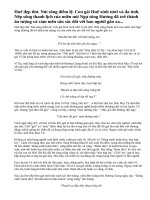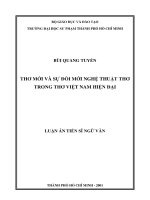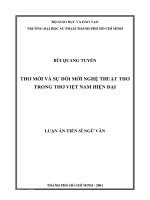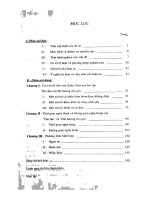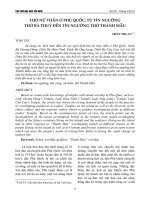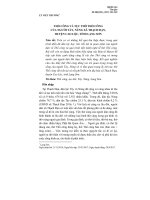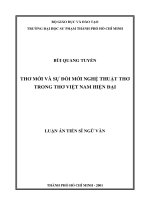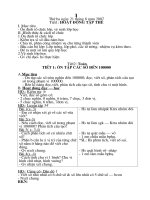Thơ không vần tuyển tập tân hình thức
Bạn đang xem bản rút gọn của tài liệu. Xem và tải ngay bản đầy đủ của tài liệu tại đây (1.75 MB, 497 trang )
Tai Lieu Chat Luong
BLANK VERSE
AN ANTHOLOGY OF VIETNAMESE NEW
FORMALISM POETRY
THƠ KHÔNG VẦN
TUYỂN TẬP TÂN HÌNH THỨC
Tan Hinh Thuc Publishing Club
2009
Tan Hinh Thuc Publishing Club
P. O. Box 1745
Garden Grove, CA 92842
World Wide Web Site
©2009 by Tân Hình thức
All rights reserved
Cover Design
Nguyễn Trọng Khôi
Printed in The United States of America
Blank Verse
Thơ Không Vần
Edited by Khế Iêm
Translated by DoVinh
Library of Congress Control Number: 2006903156
ISBN 0-9778742-0-6
ENGLISH SECTIONS
PHẦN TIẾNG ANH
_________________
ACKNOWLEDGEMENTS
________________________
W
e would like to thank the Poet and Translator Joseph Đỗ
Vinh and the poets Donna Hallman who have given us
valuable editorial advice. Especially we would like to thank Dr.
Carol J. Compton for her edits and comments. In accordance
with guidelines established at the start of this project, Đỗ Vinh
remains the sole translator of all poetry appearing this anthology.
Thus, other translated versions are not published. We would also
like to express our deepest appreciation to the following Poets
and Colleagues who have contributed to our printing cost through
sponsorship and by placing book orders in advance: Hải Vân,
Nguyễn Lương Ba, Nguyễn Thị Thanh Bình, Nguyễn Thị Hoàng
Bắc, Nguyễn Tuyết Trinh, Phạm Chung, Quỳnh Thi, and Trương
Vũ... We have managed to bring this anthology to publication only
through the generous contributions of our readers, and we would
like to thank each and every one of you for your support and dedication. With your continued help, we can look forward to many
more future publications. Finally, we apologize for any shortcomings that may appear and acknowledge your criticism as an essential component in advancing any literary venture.
Blank Verse • 6
CONTENTS
__________
Acknowledgement
Translator’s Foreword
Introduction
Preface
Bùi Chát
Notes
Dã Thảo
Faraway Love
Duary of A Raining Day
Đặng Thân
The First Tsunami of The New Year
Đinh Cường
Like Someone’s Face
Đình Nguyên
Call It Living
Đỗ Kh.
The Attendant Lady
Joseph Đỗ Vĩnh Tài
A Suicide Note
Đoàn Minh Hải
Releasing Reincarnation
Đức Phổ
Act...
Gyảng Anh Iên
Question
Hà Nguyên Du
Every Poem Is An Epitaph
Hải Vân
7 • Tân Hình Thức
Midnight Ocean
Hồ Quỳnh Như
Insect Nights
Hoàng Xuân Sơn
Reading The Journal
Huỳnh Hữu Ủy
A Bright Shining Star...
Huỳnh Lê Nhật Tấn
Links
Inrasara
Stories Retold Only After 40 Years
Khánh Hà
Five O’Clock Rhythm
Khế Iêm
The Black Cat
A Death on Television
Khúc Duy
Fine Flour
Khúc Minh
I Marry Young Wives
La Toàn Vinh
Lottering Around The Lake
Lê Giang Trần
Another Dream
Linh Vũ
Recollection. Dims
Lưu Hy Lạc
Night in Tenderloin
Lý Đợi
A Night in Sydney
Mai Ninh
Legend
Mai Phương
That Place Long Ago
Blank Verse • 8
Nam Du
The Color of Our Homeland’s Skies
Nguyễn Cảnh Nguyên
A Little Memory of Monaco
Nguyễn Đăng Thường
Corpse, Just Chatting
Nguyễn Đăng Tuấn
She
Nguyễn Đạt
To Speak Again of The Old House
Nguyễn Hoài Phương
Lip Licks
Nguyễn Hữu Viện
My Beloved’s Virtual Footsteps...
Nguyễn Lương Ba
Tsunami Tsunami
Crossing The River
Nguyễn Phan Thịnh
My Dream
Nguyễn Phúc Bảo Tiên
A Family Tale
Nguyễn Thị Khánh Minh
A Place To Have Early Morning Coffee
Stirring All Around
Nguyễn Thị Ngọc Lan
Two-Two Melody
Nguyễn Thị Thanh Bình
Going and Coming
Nguyễn Tiến Đức
The Missing Cats
Nguyễn Tư Phương
Morning At “The Second Cup”
Nguyễn Tuyết Trinh
Heavenly Dreams
NP
9 • Tân Hình Thức
A Lullaby and You
Phạm An Nhiên
Seasons’s Calling
Phạm Chung
A Glance At Declination
Phạm Việt Cường
Smoke
Phan Đình Ngọc Cẩm
In A Fever
Phan Tấn Hải
The Person Standing on The Curb
Phan Thị Trọng Tuyến
Hungry and Cold Particles
Quốc Sinh
Sick
Quỳnh Thi
The Nun
Thiện Hiếu
Seen
Trà Đóa
Life Is So Good Already
Trầm Phục Khắc
Rapping
Trần Kiêu Bạc
Remembering A place...
Trần Thị Minh Nguyệt
Until There Is No More Breath
Trần Tiến Dũng
The Homeland Bends Down
Tunisia
The Hen and Its Chicks
Việt Hà
The Woman In The Middle Of The Station
Vũ Huy Quang
Xích Long
Ý Liên
Making Poetry Also Requires Democracy
The Eyes Of Bruce Lee
Night and Dream
Afterword
How to Read Vietnamese
New Formaism Poetry
Contributors’ Notes
11 • Tân Hình Thức
TRANSLATOR’S FOREWORD
____________________________
Đỗ Vinh
W
ith the encouragement of our Editor, the poet Khe Iem, I
would like to share a few thoughts with the authors and
readers of this collection (anthology) of poetry. First, let me thank
all the poets who have given me the opportunity to befriend them
through their poetry. Although I did not embrace and adore each
word, each verse, each poem, as the poets had when they wrote
their poems, I did my best to bring clear meaning and to do justice to your carefully chosen poems through my very meticulous,
mindful, respectful and refined art of translation. The act of translation is in itself a creative endeavor, not entirely mechanical and
principle-driven. Yet, regardless of my skills, I could not translate
a “bad” poem into a “good” poem— I could only do the opposite.
Thus, if I had accomplished the translation task that our Editor and
poets had assigned to me, then I would be entitled to all the honor
and satisfaction of a doula who have eased the transition from the
poets’ mother tongue to ‘new flowery-butterfly life of different
colors’ (a verse from the poem ‘Early Spring Days’, Green Plums
by Do Vinh). If I had erred and stifled the poems, causing them to
take on strange forms, then the mistakes are mine alone and I accept full responsibility. Please let me apologize now to our poets
and readers and ask for your forgiveness. Finally, let me thank our
readers, supporters and especially our editor, Khe Iem, who had
given me the opportunity to witness history in the making with
the publication of an anthology of over 60 poets and 70 poems. It
is my conviction that this publication will not only launch Vietnamese poetry into the mainstream of world poetry-literature, but
Blank Verse • 12
squarely place us in the forefront of achievement in this field from
the 21st century onward into the indefinite future. Only now can
we claim a true watermark for the advancement of our country’s
poetry-literature, for the Vietnamese language, and for world poetry-literature. Please allow me to humbly congratulate our poets,
readers and friends, and again, thank you all for this once-in-alifetime chance to shine with you in this brave, bold movement.
13 • Tân Hình Thức
INTRODUCTION
NEW FORMALISM
THE BEAT OF A NEW ERA
_______________________
Đặng Tiến
Vietnamese New Formalism is a new school of poetry which has
been spreading in recent years, beginning with the Vietnamese
Journal of Poetry (Tạp Chí Thơ) which is published in the United
States. Most notable was the publication of issue18, spring 2000,
“The Change of Centuries», demonstrating its growing influence
with the enthusiastic participation of many writers and poets from
within Vietnam and abroad. The name “Vietnamese New Formalism” coined from New Formalism which was flourished in USA
during the 1980-1990 period.
Vietnamese New Formalism poetry has these particular characteristics:
– Consists of non-rhyming verses, entirely different from the
rhyme-schemes of classical poetry, yet presented on the page in a
manner similar to that of a traditional poem; easily recognizable
as a poem.
– Each classical verse of poetry includes five, six, usually seven, or
eight words (syllables), sometimes alternating 6-8 syllable verses,
organized into stanzas of four lines or of multiple lines. Enjambments occur at the exact number in the syllable count, without
Blank Verse • 14
deference to the grammar or to the meaning of a sentence. From
the first to the last verse, it is the same throughout, sometimes
punctuated, sometimes not.
– Strings sentences together as the author tells a story, one story
overlapping the next, sometimes clear, sometimes unclear.
– Employs the vernacular, common and sometimes profane, of the
average person using everyday language in normal daily activities.
Lacks the classical usage of flowery words found in methaphors,
metonymy, and parallel constructions, but employs repetition to
create rhythm in a verse.
These poets appear to take pride in bringing normal, everyday life
into poetry and in breathing poetry into life, thus reforming and
even revolutionizing it. Tạp Chí Thơ wrote:
“If we are unable to bring normal every day sayings into
poetry, then how can we bring life into poetry? And thus,
how are we able to share the joy and pain of every sector
of society, so that poetry can become the voice of this new
era?”1
In some sense, they are right. Vietnamese New Formalism poetry
is a type of modern folk poetry, not the kind of poetry that has become literature and selected for lectures in the schools under intellectual scrutiny, but the kind of poetry that permeates the common
folk, reflecting their ordinary daily activities. For instance, these
two sayings are from lullabies :
Saying A, similar to New Formalism poetry:
Hai tay cầm bốn tao nơi
Tao mơ thẳng thì thơi
Tao mơ dùi thì sửa lại cho cân.
15 • Tân Hình Thức
Two hands gripping four ropes’cradle
Let them be, the ropes that are tight
Pull hard to fix the ones that aren’t.
Saying B, similar to classical poetry:
Hai tay cầm bốn tao nôi
Tao thẳng, tao dùi, tao nhớ, tao thương.
Two hands gripping four ropes’ cradle
One tight, one loose, one to remember, one to love.
Nôm poetry by Nguyễn Khuyến:
Năm nay cày cấy vẫn chân thua
Chiêm mất đằng chiêm, mùa mất mùa
Phần thuế quan thu, phần trả nợ
Nửa cơng đứa ở, nửa th bị
Sớm trưa dưa muối cho qua bữa
Chợ búa trầu chè chẳng dám mua.
This year farm work has truly failed
Season after season, loss of rice
Part goes to taxes, part goes to debts
Half pays a servant, half pays a cow’s rent
Breakfast and lunch of salty pickles
At the market, betel and tea we cannot dare to buy.
This is a poem written in the conforming classical Tang-style,
very exact in its format. But if we look beyond the confines of its
formalities, we will find it to be a most «New Formalism» poem,
in the deepest sense: bringing ordinary language and life into poetry. If the late great Tam Nguyên was alive in this day and age of
New Formalism, perhaps the prolific poets Đỗ Kh. and Nguyễn
Đăng Thường would not be so bold, and Khế Iêm would not have
to spend hundreds of pages to discuss ôthe butterfly effectằ.2
Blank Verse ã 16
In addition, I believe that the first poet of Vietnamese New Formalism was Nguyễn Văn Vĩnh, when he wrote the line ‘The ve
cry ve-ve’ (ve = cicada) in 1914, very new formalism. On the contrary, a common saying of common folk is: ‘Hear ye, hear ye / The
sounds of gambling / Fluttering in the mornings...’ again, a very
classical verse, in the vein of traditional poetry.
Nguyễn Văn Vĩnh revealed that before he translated La Fontaine’s
fable, The Cicada and the Ant, he had never written poetry, nor
even tried his hand at it. The verse ‘The ve cry ve-ve’ perhaps
came to him naturally, arising out of the original French, Nguyễn
Văn Vĩnh did not intend to reform or mordernize literature at all.
Yet indirectly, he had changed the paradigm between poetry and
life and cut a new course in the literary psyche of the Vietnamese
although, in reality, that particular verse did not have any significant affect upon our literature. It was the later poets who were
conscious of the efforts to reform Vietnamese literature in more
direct ways.
The use of enjambment techniques to accent a certain word or image, often encountered in Thơ Mới (New Poetry), is an approach
adopted from French poetry. By the time of Bích Khê (1915-1946)
enjambment had become a perfected technique, with its own aesthetic value, such as that found in the poem Duy Tân (1941):
Người họa điệu với thiên nhiên, ân ái
Buồn, và xanh trời. (Tơi trơi với bờ
Êm biếc — khóc với thu — lời úa ngô
Vàng & Khi cách biệt — giữa hồn xây mộ —
Tình hơm qua — dài hơm nay thương nhớ..)
Humans in harmony with nature, passionate, sad, and blue
As the heavens. (I float like the shorelines that are clear
Green – crying with the autumn – wilting words, yellow maple
Leaves & Once separated – a cemetery amidst souls – Yesterday’s
love – extending long into today’s memory..)
17 • Tân Hình Thức
In his foreword to The Poetry of Bích Khê (1988), Chế Lan Viên
confesses Bích Khê’s influence in his own poetry; an example appears in the poem “Tập Qua Hàng” (Passing By the Lines):
Chỉ một ngày nữa thôi. Em sẽ
Trở về. Nắng sáng cũng mong. Cây
Cũng nhớ. Ngõ cũng chờ. Và bướm
Cũng thêm màu trên cánh đang bay 3
Just one more day. You will
Return. The morning sun longs for you. The
Trees also remember. The roads await.
And butterflies’ wings fly more colorfully
This poem is not quite New Formalism yet because it still has the
rhyme cây – bay, but this rhyme does not have any function here.
Minus the rhyme, by replacing the word cây with the word vườn,
for instance, and re-ordering the verse, we can make:
Chỉ một ngày nữa thôi em sẽ
trở về nắng sáng cũng mong vườn
cũng nhớ ngõ cũng chờ và bướm
cũng thêm màu trên cánh đang bay
In this revised format, it would be a great addition to the Vietnamese Journal of Poetry (Tạp Chí Thơ) publication!
When we cite these examples, it is to show that oftentimes, it is
unclear where the boundaries between schools and delineations
between periods of modern and classical poetry really are. In that
spirit, it could be said that Vietnamese New Formalism is a variation of folk poetry; and we agree whole heartedly with Khế Iêm
when he wrote, «Looking back upon past eras, from the traditional to free-style, and to new formalism, poetry has always been
a vital thread that is dynamic and ever changing, becoming the
Blank Verse • 18
beat of each and every era”.4 As one of the original proponents of
New Formalism, and perhaps its most devoted advocate, Khế Iêm
wrote:
“Each literary period bears its own unique aesthetic sensibility and historical values. Yet the paradox is there, the
creative process is also the negation process. What we
express about pre-war (traditional) poetry or free-style
is just a deconstruction of ourselves because we had in
the past composed poetry in the traditional and free-style
form before switching to New Formalism.”5
(Khế Iêm has published two collections of poetry Thanh Xuân,
‘Youth’ 1992, in rhymed verses and Dấu Quê ‘Vestiges of The
Homeland’ 1996, in free-verse form.)
While in America, New Formalism only emerged as a new form
of writing in the 1980s under the auspices of Neo-formalism. It
was not until 1996 that 25 poets came together under the label
of New Formalism and took center stage with their collection of
poetry, “Rebel Angels”. 6 But apparently New Formalism poetry
had its origins in France, starting with the works of Jean Ristat,
Từ Khúc Giục Mùa Xuân Rảo Bước (Ode pour hâter la venue du
Printemps) published in a series in the magazine La Nouvelle Critique from 1977 to1978. A popular form of French poetry is the
Alexandrin, twelve syllables in length as French is a polysyllabic
language. With every twelve-syllable count, there is enjambment
and a new line is started below, regardless of the grammar and
word structures. Đỗ Kh. had translated this poem, also using the
same enjambment technique, but with 6-8 syllable verses, since
they appear more «traditional» (to Vietnamese): a new line is entered after every sixth or eighth word, and this can continue for a
thousand lines.7 The excerpts of these translations were published
sporadically in magazines such as Hợp Lưu, and Tạp Chí Thơ,
issue 2 (1994), issue 18 (2000). The poet Nguyễn Đăng Thường,
19 • Tân Hình Thức
residing in London, who contributed to the translations, was inspired by the translated poems and wrote his own poem of thirtyone stanzas of five lines each, also using the enjambment format
of New Formalism poetry, but in the seven-syllable style. That is
the poem “Những Nụ Hồng của Máu” (Roses of Blood), critically
acclaimed for its avant garde and original quality. This poem was
published in the magazine Thế Kỷ 21, issue 27, July 1991, in California. Perhaps this is the first New Formalist poem, appearing
about the same time as that of Đỗ Kh. whose translations recently
were reprinted by Nguyễn Đăng Thường in an arts-and-craft format, by the Giọt Sương Hoa publishing house.
In a footnote to the translation, Đỗ Kh. carefully noted the political
context of the poem, wherein the poet Jean Ristat had composed
the poem with the ambition to «reform» the Communist Party of
France ahead of its 22nd Convention in the year 1977. That explains the images of a «hurried spring» giục giã mùa xuân. He
also notes that it is an Ode, thus, of course, it is also a love poem.
Jean Ristat was the boyfriend of Aragon, his secretary and the heir
to Aragon’s literary legacy. The poem has homosexual inuendos.
Generally speaking, New Formalism poetry in Europe and America falls into a special cultural category alongside the Women’s
Rights Movement, Homosexual Rights, Anti-War Movements
and even the Vietnam Syndrome Movement.
Thus, when the Vietnamese Poetry Journal Tạp Chí Thơ proclaims:
“New Formalism is the harmonious continuity between
the past and the present, between traditional and free
verse, between diverse cultures, and to a deeper degree, a
conciliation of the conflicts that had long been ingrained
in the subconscious, not only of any single race of people,
but all of humanity for from centuries past. We have had
the good fortune in the past quarter of a century to learn
and absorb the best that world civilizations has to offer
Blank Verse • 20
and to apply them through appropriate means of communication and languages, thereby enriching Vietnamese
poetry.” 8
It appears presumptious, yet it is an honest ambition. The authors
are people who have deep understanding of literature and of their
role in it. They are willing to sacrifice themselves (financially, in
some instances) to promote the cause of poetry without any ulterior political or literary motives. Even a decade later, they are
still quiety working in solitude and sometimes may be envied by
people who have negative preconceptions and biases, without
enjoying acclaim like the Dadaists in Europe at the turn of the
last century, or the Xuân Thu Nhã Tập (Spring-Autumn Literary
Movement) group in Việt Nam around the same period.
In the final estimate, life and poetry both have their destinies.
Phan Khơi rose to fame with the poem “Tình Già” (Old Love)
published in 1932 in Phụ Nữ Tân Văn. Today, it would be difficult
to find a magazine willing to print a poem like “Tình Già”; and
even if one did publish it, it would not receive the same acclaim.
Should there be such a clamor, it would only further frustrate the
author. A reincarnated Phan would probably just swear it off.
More recently, the poet Chân Phương, previously associated with
the Tạp Chí Thơ poetry circle, wrote a critical essay about Vietnamese New Formalism poetry, regarding it as “an inappropriate
copy, turning enjambment techniques into a mechanical trick devoid of any thinking.” 9 I believe the Vietnamese New Formalism poets do indeed “respect the rules and regulations,” at least
subconsciously. Take for example, an analysis appearing in Tạp
Chí Thơ issue 20, in the poem “Giữa Những Dòng Thơ” (Between
The Verses) written by Phan Tấn Hải; the hidden structure is a
five-word verse. Khế Iêm’s “Con Mèo Đen” (The Black Cat) is a
poem comprised of eight-word lines, Nguyễn Thị Thanh Bình’s
“Mưa Muộn” (A Late Rain) is a poem of seven-word lines. Some
will ask: so why make enjambment at all? Answer: the enjamb-
21 • Tân Hình Thức
ment technique is an essential component within the whole formality of Vietnamese New Formalism poetry. Sometimes it is intended to evoke emotions, such as in the poem “Những Nụ Hồng
của Máu” (Roses of Blood) by Nguyễn Đăng Thường, referred to
in an earlier paragraph, which contains these opening verses:
Ten thousand and one rainy nights before
When Christ was crucified on the cross
In the noontime violin that day appeared
A ray of sunshine meekly shining through
The arched door suddenly striking...
The beauty of these verses is, no matter how you read it, with or
without enjambments, the poem would still be enjoyable. Thus,
we could praise the author for his clever talent, or criticize him
for his trickery, having his cake and eating it too. He explains
himself:
The poem is lengthy because I wanted to create the impression with some people that it was a kind of Chanson
du Mal Aimé, or Giây phút chạnh lòng (Affected Moments) or Le condamné à Mort of a past era, a time of
turmoil. “Những Nụ Hồng của Máu“ (Roses of Blood) is
a ballad full of ‘sound and fury’, a love poem, romantic,
comic, sarcastic, realist, surrealist, of the highest calibre,
of the lowest grade, perhaps not even poetry, (depending
on the reader), a kind of pulp fiction, soap opera, film
noir, reformed theatre, kabuki, TV, documentary film,
a confused collage painting, or masterpiece (depending
on the observer) with all the allusions of things past and
present, east and west.10
(The poems that Nguyễn Đăng Thường alludes to are of Apollinaire, Thế Lữ and Genet).
Another beauty: Nguyễn Đăng Thường coincidentally defined
New Formalism poetry in a dynamic yet also specific way, with-
Blank Verse • 22
out being aware of it. In addition, New Formalism poetry does not
entirely break with tradition, rather, it embraces diversity, chaos
and all sorts of baggage from the past.
*
Aspiring to bring common language, common life into poetry.
Unfortunately, how can one know which normal life it refers to?
In the same New Formalism vein, Mai Ninh composed a poem
while on a cruise ship touring the Nil River; Trọng Tuyến writes
poetry while attending a science convention in Japan; Thanh Bình
writes while riding a back wind in springtime on her way to Đinh
Cường’s house on a prairie; and Đinh Cường writes poems while
painting in Virginia; Đỗ Minh Tuấn writes poetry while repairing plumbing in Hà Nội; and Đỗ Kh. writes poetry while having
fun with making love somewhere around the world and sighs not
so much ecstasy. So what is the common life? What is common
language?
Thus, Vietnamese New Formalism poetry plods along. In traditional-classical poetry, from Nguyễn Trãi to Xuân Diệu, five hundred years apart, the poetic verse did not undergo much change.
Between Lưu Hy Lạc and Phan Nhiên Hạo, only a few afternoons
apart, a few streets, and yet their New Formalism poems are so
definintely different!
That is nothing compared to the distances in mountains and rivers,
walls and fences, firewalls and bamboo gates. Poetry, intitially,
is a playful verse of a song, later taking on speech, and ideations
from the greater society, the advantages and power of authority
and government. The friends of Tạp Chí Thơ are led by Khế Iêm,
who holds only a candle in his hand. For the past decade, he has
sought «the butterfly effect»11 with the light of his candle. Khế Iêm
understands the difficulties of New Formalism poetry of the great-
23 • Tân Hình Thức
est concern is the lack of young readers. The overseas Vietnamese
diaspora generally does not read Vietnamese. While in Vietnam,
few have even heard of New Formalism poetry, not because it
lacks literary value, but because its distribution and diffusion is
limited by a regulated press that is subject to government control.
As in literature and the arts, a society advances when its politics
is a product of culture. Society becomes backward and unable to
grow when culture becomes a tool of politics. The future of poetry, including that of New Formalism, lies in the borderlands between these polarities.
From the times of the Book of Poetry of Confucius, to the Poetics of Aristotle, to the modern day, more than two thousand years
have transpired; the story of Poetry has been told and retold ad
nausium. But these two verses still rings delightfully:
“Fukkit, let’s split this grenade between us. Me, no tough shit.
One needs a piece of one’s heart involved in Poetry.”
These lines belong to no one but Đỗ Kh., I just don’t remember
which piece he puts them in. Can’t find him anywhere to ask. So,
heh Khiêm, you write these lines in which poems?
New Year of the Dog – Tết Bính Tuất
02/02/2006
______________________
Notes
1 . Tạp chí Thơ, issue 20, page 73, 2001, California
2. Khế Iêm, New Formalism, pages 35-74, Văn Mới publishing house,
2003, California. Theory of New Formalism Poetry, 180 pages.
Blank Verse • 24
3. Chế Lan Viên, Anthology, page 282, Văn Học Publishing House,
1983, extract from Hái Theo Mùa, 1973-1977
4. Khế Iêm, New Formalism, page 19, Văn Mới publishing house, 2003,
California.
5. Khế Iêm, Tạp Chí Thơ, page 114, issue 21, 2001, California.
6. Editors Mark Jarman and David Mason, Rebel Angels, Story Line
Press, 1996, Oregon, reprinted 1998.
8. Jean Ristat, Ode pour hâter la venue du Printemps, Gallimard, 1978,
translated by Đỗ Kh., Đoản Khúc Để Mùa Xuân Đến Vội, Giọt Sương
Hoa, 2001, London. E-mail: , giá 5 Euros.
9. Tạp Chí Thơ, page 75, issue 20, 2001.
10. Chân Phương, Tạp Chí Văn Học, page 74, issue 226, July-August,
2005, California.
11. Nguyễn Đăng Thưịng, Tạp Chí Thơ, page 124, issue 18, 2000.
12. Extract from Chaos Theory.
13. As of date, I know of three Vietnamese New Formalism poetry collections that have been published:
In Vietnam: Đoàn Minh Hải, Đại Nguyện của Đá, 2002.
In America: Lưu Hy Lạc, 26 Bài Thơ Tân Hình Thức, Giọt Sưong Hoa,
2002; Hà Nguyên Du, Gene Đại Dương, nxb Tạp Chí Thơ, 2003.
25 • Tân Hình Thức
